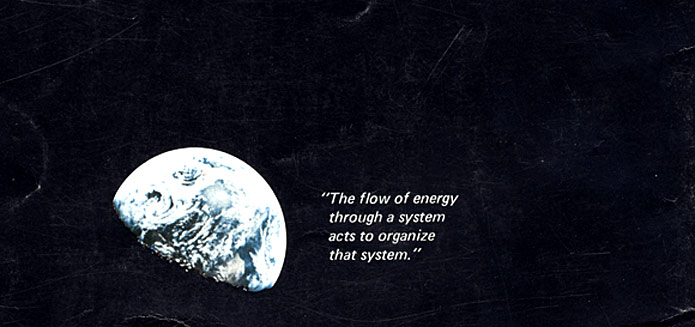Sustainabilities: Eco-oriented | Market-oriented | Utopian

The back of the Whole Earth Catalog in 1969, showing a NASA-mission image of Earth from space.
Initially founded as a hippie almanac and merchandise catalog to support the West Coast countercultural commune movement, the “classic” editions of the Whole Earth Catalog were published in the Bay Area of Northern California from 1968 to 1974 (revivals of the Catalog appeared in 1980, 1986 and 1994). It became a multi-million-copy worldwide bestseller, winning the 1972 U.S. National Book Award.
Filled with its readers’ recommendations for products ranging from books to outdoor equipment, from seeds to electronics, and edited by the countercultural entrepreneur and journalist Stewart Brand, one of the Whole Earth Catalog’s initial missions was to promote the world-saving potential of inventor Richard Buckminster Fuller’s “Design Science.” Since the 1920s, Fuller had called for an integration of technology with natural law (suspending structures rather than having them fight gravity, for instance). This, Fuller believed, would allow for a sparing use of the world’s resources preliminary to their redistribution. This was the proto-sustainability popularized by the Catalog, and significantly it reapportioned responsibility for ecological and political stewardship from government to industry and citizenry, urging a bottom-up response to crisis—a sort of libertarian reformism. The Catalog accordingly advertised itself as a point of “access to tools” with a “Do-It-Yourself” approach to resource conservation, which closely allied it with the Appropriate Technology movement gaining ground in the early 1970s.
Another Catalog priority was the reconceptualization of the world as a co-evolving cybernetic feedback system. If this would later prove inspirational to the network globalization vision of Silicon Valley, it would also be central to the more richly defined understandings of sustainability, in which maintenance of the world, far from being sumptuary, can be pursuant of a new, festive exchange between knowledge, the world, and one another. Cybernetics originated in Norbert Wiener’s wartime study of organic and technical systems of control, and flourished through post-War systems theory and computing. But the Catalog also explored more esoteric “second-order” cybernetics, described by Gregory Bateson as an “ecology of mind.” Bateson held that systems work within systems, as a larger “ecology of mind” that conjoined humans to one another and to nature.
Though the Catalog was founded to support countercultural communes, it more importantly imagined the whole world as a communitarian entity, networked mentally, emotionally, and technologically. Brand explained that “Evolution is adapting to meet one’s needs. Coevolution, the larger view, is adapting to meet each other’s needs.” While the Catalog was antipathetic to communism, and even to the New Left which was questioning communist orthodoxy (the Catalog preferred Jeffersonian American freedoms and was appalled by the centralized industrialization of the world’s advanced economies, east and west), its editors were enthralled by the prospect of an intelligent interdependence needed, they believe, for the sustenance of “Spaceship Earth” (to use Fuller’s term). Everything was to be sustained—nature, culture, competition—because underwriting the Whole Earth project were its editors’ fascinations with evolutionary and systems models that subsumed differences between people, economies, cultures, technologies, and species into one whole.
The Catalog’s global vision therefore took it far beyond countercultural merchandizing. In 1968 the covers of the Catalog offered the nearest thing to a secular image of totality that was technically possible: the new images of the Earth taken by NASA from outer space. Each subsequent cover refigured viewers’ perceptions of the Earth—views from the Moon, for instance, or of the sky photographed through a fish-eye lens to make it appear like the “blue marble” images of Earth. This continual play upon readers’ assumptions, so central to the Catalog ethos, was an enjoyable “disruption,” to coin that latter-day keyword of Silicon Valley. The Catalog was to become a central part of Valley lore for its technological and pragmatic solutions to the world’s problems. (The Catalog was sometimes edited from its Whole Earth Truck Store outlet in Menlo Park, at the heart of what is now loosely known as Silicon Valley.) An influential circle of activists was able to network around the Catalog, for example through its spinoff periodical, the CoEvolution Quarterly (1974–1985, later refigured as the Whole Earth Review). Perhaps most notably, Stewart Brand was retained from 1977 to 1979 as a consultant to a young Governor Jerry Brown, who hoped to make California into a model “ecotopian” state.
In the view of the Whole Earth Catalog, threats to sustainability included fragmented knowledge, entropy, corporatism, and hegemony. Its emphasis instead on self-reliance made it disinterested, however, in problems of justice. The extraordinarily complex legacy of the Whole Earth Catalog is then that it can be read as at once radical—as a call to the communitarian redistribution of the world’s resources, and to the empowerment of all people and species—and as supportive of a status quo based around commerce, the extension of networked control technologies, an American worldview, and an antipathy to political disputation.
– Simon Sadler
Published February 10, 2016

